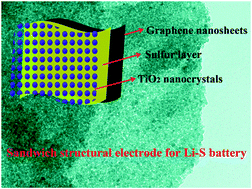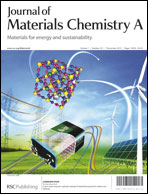Fabrication of a sandwich structured electrode for high-performance lithium–sulfur batteries†
Abstract
Lithium–sulfur (Li–S) batteries are receiving intense interest because of their high theoretical energy density. However, rapid capacity fading is a significant problem facing its practical realization. Here we present the fabrication of a sandwich structured electrode by confining elemental sulfur in a TiO2 nanocrystal (3–5 nm) decorated graphene nanosheet host (graphene/TiO2). Elemental sulfur occupies the inter-particle mesopores of the TiO2 nanocrystal layer and is in intimate contact with the graphene. The sandwich structured graphene/TiO2/S electrode exhibits enhanced cycling stability with high specific capacity and high Coulombic efficiency. The enhanced electrochemical performance is highly related to the well-defined sandwich structure and the in situ formation of a mixed ionic/electronic conductor (LixTiO2). The sandwich structure could favor rapid diffusion of the electrolyte during the charge–discharge process. Pore absorption of the graphene/TiO2 host and the on-site adsorption of the TiO2 nanocrystals could alleviate the dissolution and shuttling of the polysulfides. More importantly, the in situ formed LixTiO2 works synergistically with the highly conductive graphene layer to facilitate easier Li+/e− transport. The sandwich structure plus the unique functions of the graphene/TiO2 host conceptually provide new opportunities to achieve the long-term cycling stability of a sulfur electrode.


 Please wait while we load your content...
Please wait while we load your content...